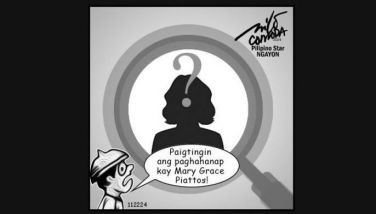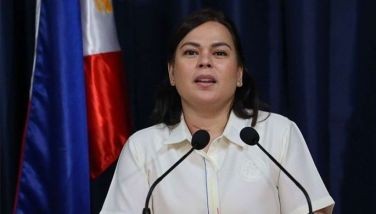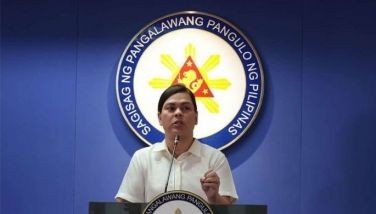Manila’s North Cemetery: Where history’s heroes rest
November 1, 2002 | 12:00am
At Metro Manila’s largest public burial ground, a visit to departed loved ones can offer a glimpse of the country’s colorful past as well.
This is because the North Cemetery in Manila serves the final resting place for key figures in Philippine history, including former presidents, revolutionary heroes and other men and women of notable achievement.
Recently, visitors from Germany, France, and the US joined local journalists as well as members of the Heritage Conservationists Society (HCS) in a historical tour of the North Cemetery.
Upon entering the main gate of the cemetery along A. Bonifacio Avenue, visitors are greeted by a 14-feet high concrete wall surrounding the tomb of Quintin Paredes, who served as president of the Philippine Senate presidents.
Across his tomb are those of the renowned Nakpils, including Julio Nakpil, composer of the Katipunan anthem and his only son Juan, a national artist for architecture who designed more than 200 buildings, churches, universities and hospitals in his lifetime. His more prominent works include the Quiapo Church, the Manila Jockey Club and the Quezon Institute.
One can also see the catacomb of Gregoria de Jesus, the Katipunan muse and widow of Andres Bonifacio. Three years after the father of the Katipunan died, De Jesus married Julio Nakpil.
A few steps away from the Nakpil tombs is that of Arsenio Lacson, recognized as the finest mayor Manila ever had. Lacson was the first mayor after the World War II and was credited for instilling discipline in the country’s capital during his term from 1951 to 1962.
Along the main avenue of the cemetery is the tomb of former President Serge Osmeña (1878-1961). Osmeña worked for the restoration of executive departments that existed before the World War II.
Near his tomb is that of ultra-nationalist senator Claro M. Recto (1890-1960) who defended Philippine interest against the Americans.
One of the most prominent is the tomb of former President Ramon Magsaysay (1907-1957), the third president of the Republic. Magsaysay is known as the "president of the masses," being the first Chief Executive to open Malacañang’s gates for the masses.
Also located in the cemetery is the tomb of former President Manuel Roxas as well as the mausoleum of the SS Thomasites, a group of Americans who traveled to the Philippine islands to educate Filipinos, whom they called "little brown brothers."
Other notable areas of interest are the Mousoleo de los Veteranos de la Revolucion and the tomb of national artist for Architecture Arcadio Arellano, who designed the Manila City Hall. There is also a compound for Manila Police Department, now known now as Western Police District, for policemen who died in the line of duty.
Carlos Celdran, HCS development officer, said it was the second time the group has conducted a tour of the Northern Cemetery. Last year’s tour was also held a few days before All Saints’ Day.
Celdran said are planning to conduct similar tours annually.
This is because the North Cemetery in Manila serves the final resting place for key figures in Philippine history, including former presidents, revolutionary heroes and other men and women of notable achievement.
Recently, visitors from Germany, France, and the US joined local journalists as well as members of the Heritage Conservationists Society (HCS) in a historical tour of the North Cemetery.
Upon entering the main gate of the cemetery along A. Bonifacio Avenue, visitors are greeted by a 14-feet high concrete wall surrounding the tomb of Quintin Paredes, who served as president of the Philippine Senate presidents.
Across his tomb are those of the renowned Nakpils, including Julio Nakpil, composer of the Katipunan anthem and his only son Juan, a national artist for architecture who designed more than 200 buildings, churches, universities and hospitals in his lifetime. His more prominent works include the Quiapo Church, the Manila Jockey Club and the Quezon Institute.
One can also see the catacomb of Gregoria de Jesus, the Katipunan muse and widow of Andres Bonifacio. Three years after the father of the Katipunan died, De Jesus married Julio Nakpil.
A few steps away from the Nakpil tombs is that of Arsenio Lacson, recognized as the finest mayor Manila ever had. Lacson was the first mayor after the World War II and was credited for instilling discipline in the country’s capital during his term from 1951 to 1962.
Along the main avenue of the cemetery is the tomb of former President Serge Osmeña (1878-1961). Osmeña worked for the restoration of executive departments that existed before the World War II.
Near his tomb is that of ultra-nationalist senator Claro M. Recto (1890-1960) who defended Philippine interest against the Americans.
One of the most prominent is the tomb of former President Ramon Magsaysay (1907-1957), the third president of the Republic. Magsaysay is known as the "president of the masses," being the first Chief Executive to open Malacañang’s gates for the masses.
Also located in the cemetery is the tomb of former President Manuel Roxas as well as the mausoleum of the SS Thomasites, a group of Americans who traveled to the Philippine islands to educate Filipinos, whom they called "little brown brothers."
Other notable areas of interest are the Mousoleo de los Veteranos de la Revolucion and the tomb of national artist for Architecture Arcadio Arellano, who designed the Manila City Hall. There is also a compound for Manila Police Department, now known now as Western Police District, for policemen who died in the line of duty.
Carlos Celdran, HCS development officer, said it was the second time the group has conducted a tour of the Northern Cemetery. Last year’s tour was also held a few days before All Saints’ Day.
Celdran said are planning to conduct similar tours annually.
BrandSpace Articles
<
>
- Latest
- Trending
Trending
Latest
Trending
Latest
Recommended


















